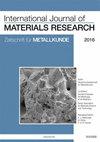Preparation of cellulose/activated carbon cells: application to the adsorption of cobalt from stagnant waters
IF 0.7
4区 材料科学
Q4 METALLURGY & METALLURGICAL ENGINEERING
引用次数: 0
Abstract
Abstract A cellulose/activated carbon combined material is prepared and tested for the adsorption of Co(II) from stagnant waters. This material is easily prepared using two different homemade activated carbons as adsorbents and sanitary paper as cellulose source. Cellulose/activated carbon cells so prepared are thoroughly characterized using multiple methods including optical imaging, tensile tests in dry and wet conditions, thermogravimetric analysis and Fourier transform infrared spectroscopy. Afterwards, they are tested for the adsorption of Co(II) from stagnant waters solutions. The results showed that the prepared cells offer good mechanical resistance; the optical microscopy images showed the dispersion of activated carbons grains between cellulose fibres while spectral analysis revealed that the activated carbons keep their chemical properties in the cells. When tested and compared to activated carbons alone for the retention of Co(II) from stagnant waters solutions, the cellulose/activated carbon cells gave better adsorption ratios for both activated carbons (up to double). This study shows an easy way to enhance the efficiency of activated carbons by dispersing their grains within cellulose fibres. Thus the added value of this work is ease of preparation, non-use of harmful chemicals and the economic aspect.纤维素/活性炭电池的制备:在吸附死水中的钴方面的应用
摘要 制备并测试了一种纤维素/活性炭组合材料,用于吸附积水中的钴(II)。使用两种不同的自制活性炭作为吸附剂和卫生纸作为纤维素源,可以轻松制备这种材料。所制备的纤维素/活性炭电池采用多种方法进行全面表征,包括光学成像、干湿条件下的拉伸试验、热重分析和傅立叶变换红外光谱。然后,对它们进行了从死水溶液中吸附 Co(II)的测试。结果表明,制备的电池具有良好的机械耐受性;光学显微镜图像显示,活性碳颗粒分散在纤维素纤维之间,而光谱分析显示,活性碳在电池中保持了其化学特性。与单独使用活性碳从死水溶液中截留钴(II)进行测试和比较时,纤维素/活性碳细胞对两种活性碳都有更好的吸附率(高达一倍)。这项研究表明,通过将活性炭颗粒分散在纤维素纤维中,可以轻松提高活性炭的效率。因此,这项工作的附加值在于易于制备、不使用有害化学物质和经济方面。
本文章由计算机程序翻译,如有差异,请以英文原文为准。
求助全文
约1分钟内获得全文
求助全文
来源期刊
CiteScore
1.30
自引率
12.50%
发文量
119
审稿时长
6.4 months
期刊介绍:
The International Journal of Materials Research (IJMR) publishes original high quality experimental and theoretical papers and reviews on basic and applied research in the field of materials science and engineering, with focus on synthesis, processing, constitution, and properties of all classes of materials. Particular emphasis is placed on microstructural design, phase relations, computational thermodynamics, and kinetics at the nano to macro scale. Contributions may also focus on progress in advanced characterization techniques. All articles are subject to thorough, independent peer review.

 求助内容:
求助内容: 应助结果提醒方式:
应助结果提醒方式:


